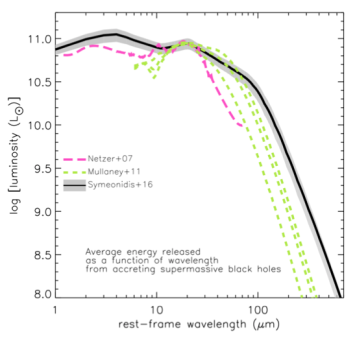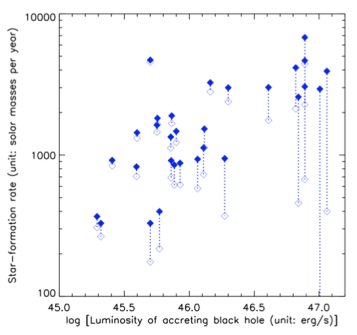Galaxies are not simply conglomerations of stars, gas and dust. They are the building blocks of the Universe, the ultimate energy factories and at least one of them is home to intelligent life. In fact, besides the Big Bang, the origin of most electromagnetic radiation in the Universe can be traced back to galaxies. Nonetheless, the existence of supermassive black holes in galaxy centres, although now well-established, is still puzzling scientists. How did these mysterious objects come to be? When did they first form? Is there one in the centre of every galaxy? More puzzling yet, is the idea that they can regulate the formation of stars in the galaxies in which they reside.
Supermassive black holes in galaxy centres accrete matter, releasing copious amounts of energy in the process, which eventually gets deposited into the interstellar and intergalactic environment. On the other hand, essential for the onset of star-formation in a galaxy is an abundance of cold, dense gas (primarily Hydrogen) eventually collapsing to form stars. Radiation produced during the accretion of matter onto supermassive black holes is the most effective mechanism we know of that can interfere with the process of star-formation over short timescales: either by heating the gas and preventing it from collapsing into stars, or by driving the gas out of the galaxy. In fact, the current cosmological paradigm that describes the bulk properties of our Universe, dominated by dark energy and cold dark matter, fails to predict the observed number of galaxies per unit luminosity and volume of space. One explanation for this failure is that accretion energy from supermassive black holes terminates star-formation in the most massive galaxies.
My field of research is focussed on galaxy evolution and in the last couple of years, I have started to contribute to our understanding of how much energy is produced by supermassive black holes at any given frequency: from the X-rays to the radio. Such an investigation was not possible until 2009, when the Herschel space observatory, the world’s largest space telescope to date, was launched, opening a new window on the Universe in infrared/sub-millimetre wavelengths. Using Herschel data to map the energy released in the infrared/sub-millimetre parts of the electromagnetic spectrum from accreting supermassive black holes, I recently arrived at a major breakthrough. I discovered that the intrinsic energy attributed to an accreting black hole in that wavelength range, is much larger than previously thought (Figure 1), suggesting that many estimates of star-formation rates, which are also derived using the infrared/sub-millimetre wavelength range, need to be significantly revised (Figure 2).

Figure 1: Plot taken from Symeonidis et al. (2016): the black curve shows the average energy released from accreting supermassive black holes (y-axis) as a function of wavelength (x-axis). The importance of this result rests on the shape of the curve because this represents the relative amount of energy released at each wavelength. The green and pink dashed curves are taken from previous works. Note the pronounced difference between the different curves in the infrared/submm part of the electromagnetic spectrum (20-1000μm). The curve I computed shows an excess of emission in the 20-1000μm wavelength range, indicating that previous works have significantly underestimated the emission from accreting black holes.
My findings, which have been published in Monthly Notices of the Royal Astronomical Society (volume 459; page 257), imply that major adjustments are required in the results obtained so far regarding the connection between supermassive black holes and star-formation in galaxies. More specifically:
- We need to re-calculate star-formation rates in the galaxies hosting the most luminous accreting supermassive black holes
- We need to re-evaluate what primarily powers the most massive and most luminous galaxies: stars or the supermassive black hole
- We need to adjust previous measurements of the cosmic star-formation history by removing the contribution from supermassive black holes
- We need to investigate whether there is a limit to the star-formation rate that a galaxy can have at any given epoch

Figure 2: Plot taken from Symeonidis et al. (2016). Each filled-in diamond represents a galaxy and its position shows its measured star-formation rate (y-axis) and the luminosity of the accreting supermassive black hole that resides in its centre (x-axis). These measurements are taken from the literature. The dotted lines indicate the correction that would be necessary according to my recent results and the open diamonds are now the corrected star-formation rates for each galaxy. Note that for some galaxies, star-formation rates have been overestimated by a factor of 10.
These results will be important in testing and constraining galaxy evolution models in order to understand the processes by which galaxies evolve, particularly how, when and why does star-formation end in galaxies. The outcome of this investigation will also have direct implications in other fields of astronomy, which explore the physics of star-formation, stellar evolution and galactic dust production. Moreover, correctly charting the energy deposited by supermassive black holes into their host galaxies is likely to lead to the much sought-after observational evidence for the quenching of star-formation by supermassive black holes.
By Dr Myrto Symeonidis, astrophysics researcher at MSSL
